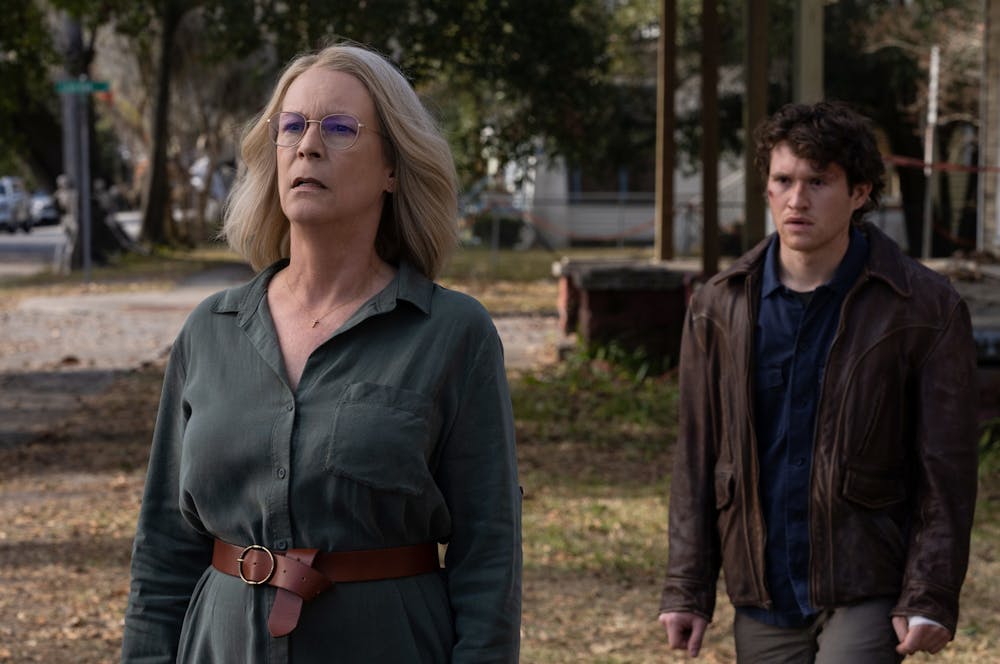SPOILER ALERT: This column contains potential spoilers about new film “Halloween Ends.”
Would you believe me if I told you one of the weirdest, most perplexing films of 2022 is the final entry in David Gordon Green’s “Halloween” trilogy? Probably not, right? The divisive response to "Halloween Ends” didn’t make sense to me either. That is, until I saw it for myself.
The film takes place four years after the events of “Halloween” and “Halloween Kills,” and finds beloved final girl Laurie Strode, played by Jamie Lee Curtis, finally living a peaceful life with her granddaughter Allyson, played by Andi Matichak, in Haddonfield, Illinois. The vanishing of Michael Myers means they can finally begin to heal — even if they know that evil is still lurking.
Related: [COLUMN: 5 unconventional horror films to watch this October]
Don’t be fooled though — much of the film revolves around an entirely new character. Corey Cunningham, played by Rohan Campbell, is a troubled young man haunted by a traumatic event from his past. Despite it being an accident, Haddonfield shuts Corey out and declares him a monster. His reputation doesn’t prevent Allyson from seeing the good in him though, and the pair of broken souls begin a relationship.
The decision to center the final Halloween film on a new character was incredibly risky. Green and his team could have easily made the film another cookie-cutter kill fest, but Corey’s storyline adds an unexpected thematic thread to the film.
The city of Haddonfield is like a character because the effect of Michael Myer’s reign is explored in detail. The town is infected with paranoia and trauma; it's rotten at the core and feeds off fear. Laurie can see the destructive path that Corey’s on, but her warnings are dismissed. Allyson becomes frustrated by her grandmother’s inability to truly grow.
Thankfully, Corey is a compelling enough character to be invested in. His inner turmoil and struggle to not surrender himself to evil brings a fresh perspective to the Halloween series. I understand why some audiences were taken back by this sudden departure from the normal story structure, but I admire the decision to try something new — even if the final product doesn’t always stick the landing.
Another divisive point in “Halloween Ends” is the size of Michael Myer’s role. He’s put on the back burner for most of the film, never really doing his normal stalk-and-kill routine we’re so used to. He finally starts to show deterioration in his old age, even if he is a somewhat mythical being. Instead of embarking on his rampage, Michael becomes a mentor for Haddonfield’s next bogeyman, only coming out of the shadows to pass the torch.
The final face-off between Laurie and Michael is a climactic confrontation over 40 years in the making. Despite it being rather short, it feels significant and borderline spiritual. Laurie’s lifelong trauma made her its captive, and she’s finally presented with the opportunity to confront its evil catalyst in the face.
Undeniably, the film has its problems. At times the writing is laughable. The pacing of the first act is slower than Michael Myer’s labored breathing. The mismarketing of "Halloween Ends” as another routine slasher resulted in audiences feeling isolated and let down by the final product.
Related: [COLUMN: 5 years after the release of ‘Columbus,’ the film’s impact is stronger than ever]
But I’m glad the film goes in a different direction. I’d much rather watch an imperfect film that isn’t afraid to take risks instead of something that’s technically competent but boring and forgettable. And who knows? Maybe the general public will warm up to “Halloween Ends” in the future, just like it did with 1982’s “Halloween III: Season of the Witch.”
Alongside films like “Barbarian” and “Smile,” “Halloween Ends” proves that mainstream genre cinema is going through a creative renaissance. Are all these films good? Not necessarily. Nevertheless, this change is a welcome one.




